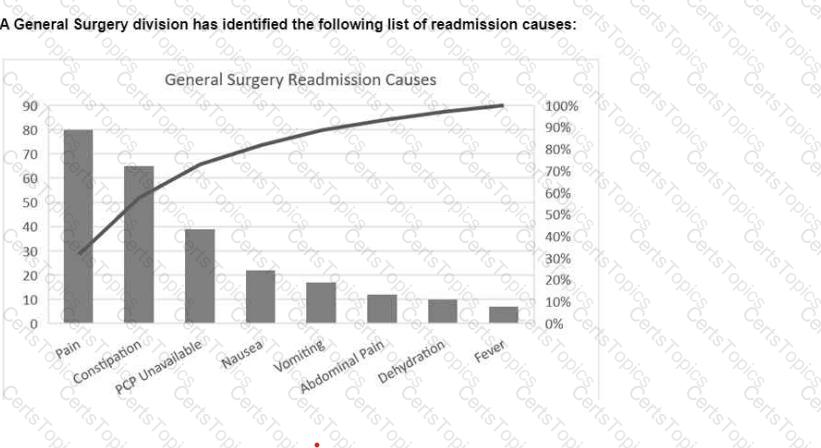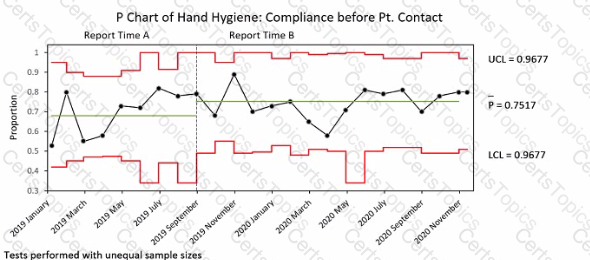A multidisciplinary team has been convened to review delays in laboratory turnaround time between the medicine clinic and the laboratory. The team’s first step in evaluating the issue is to
The safety reporting system being used by an organization cannot produce reports or information in a usable format. After evaluating the existing system and other products on the market, which of the following should the quality professional do before making recommendations to leadership?
Using clinical guidelines based on scientific evidence will most likely
A Pareto chart can be used to
Which of the following is the key responsibility of a healthcare quality professional in all types of facilities and organizations?
Which tool Is used to Identify resources needed to complete a project?
Which of the following infection prevention techniques represents a human factors engineering solution?
Performance Improvement plans are most successful when linked first with
Which initiative should a quality professional promote in an organization seeking to optimize value-based reimbursement?
For which incident would a process improvement manager be required to perform a root cause analysis (RCA)?
Which of the following is the best example of a patient-centered approach in healthcare?
A pulmonologist is gathering social determinants of health data from their patients. Which of the following best explains the purpose of collecting this data?
A recent Journal article has Identified three new patient safety Initiatives. When reviewing these Initiatives, the first action of a healthcare quality professional Is to
To determine how much variability in a process Is due to random variation and how much Is due to unique events, the most appropriate tool would be a
An effective method to increase an organization’s board of directors engagement in patient safety is to
To promote staff engagement In a new Initiative, educators should focus on staff
An ambulatory care practice has reviewed data to identify patients with multiple visits to the emergency room within the last six months. The population health management technique for this type of data review is called
Which of the following approaches best allows an agency to align Its activities with organizational goals?
A performance improvement council has been directed to set up a communication plan for spreading an innovative telehealth program throughout the healthcare system. Which of the following groups must the council include in the communication plan?
Which of the following Is an example of active surveillance?
During development of a clinical pathway, a quality professional should
In a confidential reporting system, the reporter's Identity Is
A home health agency’s Performance Improvement Committee has decided to base staff educational programs on aggregated occurrence report data. Due to budgetary and time constraints, not every area identified from the data can be addressed. Which of the following would be most useful to the committee in determining their educational targets?
An organization that demonstrates a culture of safety
The clinic has a goal to reduce the Healthcare Effectiveness Data and Information Set (HEDIS) measure of ' the percent of diabetic patients with a HgA1c greater than 9.0% for accreditation. Who should be Included on the quality Improvement team?
Which Is a source of data tor analyzing staff flu vaccination trends for an accountable care organization?
Which of the following Is an algorithm that Is designed to classify patients according to their acuity?
Which of the following Is true of a clinical pathway?
A healthcare quality professional receives complaints from numerous patients that the registration process is inefficient. Which of the following should be used to best identify customer expectations, perceptions, and improvement opportunities?
Based on the chart below, which of the following should be addressed first?

Which of the following tools Is most effective in assisting an organization seeking to evaluate the current culture of safety?
In an aging population, one of the challenges associated with the use of practice guidelines is
Which of the following is the role a healthcare quality professional should play in strategic planning?
Identification of quality Improvement opportunities can best be Identified through
In aligning an organization's performance Improvement plan with strategic goals, a healthcare quality professional should consider
A quality professional needs to select a new project from a list of requests. An organization has determined that new projects should focus on patient safety and cost-reduction. Which tool would help Identify the project that best meets these criteria?
Medication reconciliation Is described as
Which of the following is an example of a social determinant of health used to monitor a quality improvement initiative?
What Is the Initial step the quality professional should take when the organization's performance on a patient satisfaction strategic goal Is below the desired performance?
When allocating limited resources to meet strategic objectives, management decisions should be driven by
A root cause analysts (RCA) was conducted tor an event related to a delayed high-priority alarm response. Alarm fatigue was determined to be a root cause. Which of the following Is the most appropriate first Intervention?
Which of the following characteristics best describes a learning organization?
To assess compliance with quality standards, a healthcare organization needs
Ongoing practitioner practice evaluation (OPPE) Is used for which of the following?
Before patient outcome data can be used for benchmarking, the data should be
A patient safety manager provided training on hand hygiene guidelines. The clinical manager Is confident that staff are following the guidelines. Which of the following Is the best method to evaluate the current compliance with the guidelines?
Which management accountability action should be Implemented to ensure continuous readiness tor accreditation survey?
An increased number of outpatient surgery patients present to the emergency department with complaints of pain. Which would be the best strategy to address these occurrences?
Multi-voting Is frequently used in which of the following steps of the quality Improvement process?
A hospital collects patient satisfaction data by mailing surveys to patients discharged home and analyzes the responses they receive. What is the most significant limitation of this sampling methodology?
In order to make effective long-term changes, performance Improvement emphasizes the need to study and understand
The desired outcome of peer review Is to
Each department in a hospital self-monitors and reports hand hygiene data each quarter. Results typically fall within the 58-72% range, with the exception of Respiratory Therapy, which consistently reports 100% compliance. Which of the following steps should a healthcare quality professional take next?
Which of the following actions best illustrates an organization has begun the work necessary to achieve the Malcolm Baldrige Award?
A patient safety program can best be enhanced by which of the following technologies?
A patient safety manager is asked to recommend the best action to reduce medication errors at a hospital. Which of the following is the most appropriate next step?
In preparation for a provider organization accreditation survey, the most effective method for identifying training needs for staff is
A hospital is considering changing the process of admissions from the emergency department. To support patient safety when this new process is deployed, the healthcare quality professional should suggest which of the following actions during the design stage of the process?
Where in the process of ensuring correct surgery does a "time-out" take place?
Which of the following is the quality professional's first step prior to implementing a new infection prevention protocol in the clinic?
A quality improvement coordinator is asked to develop a training session on team facilitation based on adult learning principles. Which of the following would be the best approach to include?
Evaluating data to determine high utilizers of emergency departments and their related characteristics is a strategy that can best help with
The main purpose of conducting tracers as a part of continuous readiness is to
Which of the following are the three primary quality management activities?
In a quality improvement team, the primary role of the facilitator Is to
The most Important determinant of quality Improvement success is
An interdisciplinary team met to review readmission rates at a health system. Issues were identified with communication across care providers. The team is interested in improving the coordination of care process and is now reviewing four candidates to serve in the role of process champion:

Of the four candidates, which represents the most effective choice to serve as a process champion?
An organization conducts daily briefing sessions. Which of the following questions demonstrates a culture of safety?
The collection, analysis, and Interpretation of data for planning, Implementing, and evaluating health programs is
A healthcare quality professional Is assisting an organization with evaluating patient safety actions that will prevent errors of omission. Which of the following systems will most likely be effective?
Which of the following is the best strategy for executive leaders to improve patient safety within an organization?
Which of the following Is the best approach to prepare care team members tor Interacting with accreditation surveyors?
Before patient outcome data can be used for benchmarking, the data should be
Which of the following tools would be used to outline factors leading to a problem or desired outcome?
Over the past 2 months, a trend has been detected in medication errors. The preferred method of presenting data to the nursing Quality Council will identify the nurse by
An organization Is looking for a creative approach at Improving heart failure outcomes to reduce readmissions. Several clinician's express concerns that nothing can be done to Improve this. Two clinicians recommend a set of clinical practice guidelines recently developed by a specialty organization. Which of the following would the two clinicians be considered?
Which of the following is the appropriate group to review care delivered by an individual physician to a patient who suffered a serious adverse event?
Which of the following should a healthcare plan use to collect satisfaction data from its health plan members?
An organization has implemented a quality improvement project. The goal is a mean compliance rate of 90%. The results of observations are found in the table below:

Which focus area presents the greatest opportunity for the organization?
Which of the following is the most effective method to identify adverse events that cause harm to patients?
A healthcare organization has recently launched a diabetes center of excellence to address the needs of its patients with advanced diabetes. The implementation of this program would fall into which of the following types of prevention?
Leadership at an outpatient multi-specialty clinic Is working toward becoming a high-re I lability organization. In the past week, there have been three medication errors with high-risk medications in the procedure area. Which of the following responses by leadership Is consistent with high-reliability principles?
In a healthcare organization Implementing ongoing performance Improvement (PI), which of the following will most likely benefit the PI goals of the organization?
A continuous survey readiness program requires which of the following?
A criterion is considered valid if it
In recent months, the amount of time It takes for Insurance claims to be submitted has increased significantly, resulting in the hospital not being paid in a timely manner. Which of the following Is the quality professional's best course of action?
The following data are known:

Which of the following accurately describes this chart?
An ambulatory pulmonary division is in the final phase of a DMAIC project. The division head asked the team to present the performance of the project. Which chart demonstrates that change has occurred over time and the process has limited variation?
The quality manager needs to identify a set of process measures to improve wound cate outcomes. The first step should be to
When developing objectives for an educational program, the quality professional should recommend
An organization notices an Increase In medication errors In three patient care areas. Which of the following concepts will be most effective when Improving medication administration workflows?